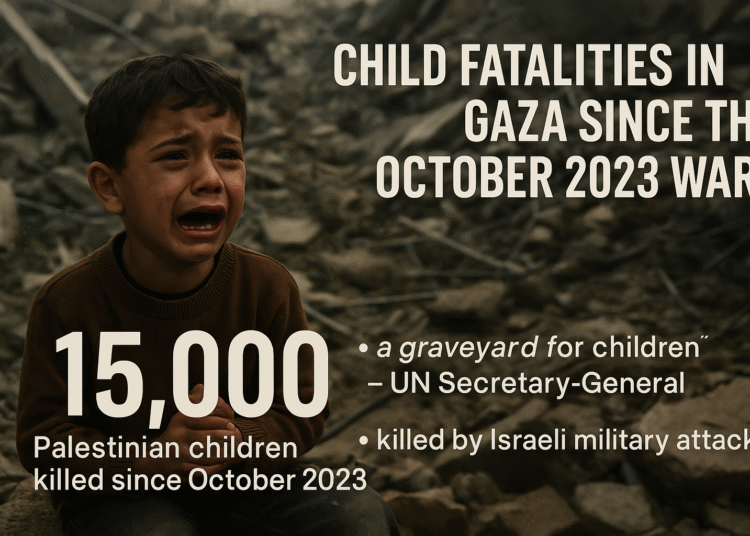The war that erupted on 7 October 2023 in Gaza has led to an unprecedented toll on children. Over a year and a half of intense bombardment and fighting has turned Gaza into what the U.N. Secretary-General called “a graveyard for children” reuters.comreuters.com. As of mid-2025, thousands of children under 18 have been killed in the Gaza Strip. This report compiles the latest verified figures on child fatalities, provides breakdowns by age, cites credible sources of data, and highlights statements by international organizations on the context and responsibility for these deaths. It also outlines the dire humanitarian situation in Gaza affecting children’s survival and well-being.
Total Number of Children Killed (October 2023 – 2025)
At least 15,000 Palestinian children in Gaza have been killed since the war began in October 2023 bbc.com. This figure, reported by UNICEF and other U.N. agencies, is based on data from Gaza’s health authorities and is widely considered credible by the U.N. and international institutions bbc.com. Palestinian officials have cited even higher numbers – for instance, the Palestinian Ministry of Education stated in April 2025 that over 17,000 children had been killed in Gaza since October 2023 aljazeera.com. While exact totals may vary by source and date, all accounts confirm a staggering scale of child loss.
- Proportion of total casualties: Children represent roughly 30–40% of all fatalities in Gaza. Early in the conflict, about “more than 40% of those killed in Gaza…are children,” according to Save the Children savethechildren.org. As of March 2025, a detailed breakdown by the Gaza Ministry of Health (MoH) showed 15,613 children among about 50,000 total deaths (≈31%) unrwa.org. This indicates that about one in every 3 civilian deaths in Gaza has been a child.
- Infants and newborns: The toll includes at least 825 infants (under 12 months old) unrwa.org. Tragically, 274 babies were born during the conflict only to die in the fighting or its aftermath unrwa.org. This underscores the vulnerability of the very youngest: some infants perished from bombs or siege conditions within days or even moments of birth.
- Comparison to population: Gaza’s entire child population is about 1.1 million. By January 2024, 10,000 child deaths amounted to roughly 1% of all children in Gaza killed in just three months savethechildren.orgsavethechildren.org. With the toll now well over 15,000, more than 1 in every 70 Gazan children has been killed since the war’s outset. UNICEF noted that this far exceeds child casualty figures from any recent conflict worldwide over a comparable period hrw.org.
- Injuries and orphans: In addition to fatalities, over 34,000 children have been injured in Gaza, often with life-altering wounds bbc.com. Thousands of children face permanent disabilities from shrapnel, burns, and the collapse of buildings. Moreover, tens of thousands have lost parents. By April 2025, Palestinian sources reported that around 39,000 children in Gaza had lost one or both parents due to the violence aljazeera.com – a generation of orphans on a massive scale.
Sources of Data and Their Credibility
Primary data sources: The casualty figures for Gaza are compiled by the Ministry of Health in Gaza, which is under the de facto Gaza authorities. These numbers are then reported by U.N. agencies (UN OCHA, UNICEF, WHO, UNRWA) and respected NGOs. For example, UN OCHA’s humanitarian updates and UNRWA situation reports regularly cite MoH data for deaths and injuries unrwa.org. The MoH has published detailed lists of the dead, including names, ages, and gender, to back its totals. International media like the BBC and agencies like UNICEF rely on these health ministry figures in the absence of alternative counts, while noting the source.
Verification: The U.N. considers the Gaza health ministry’s statistics to be generally reliable and reflective of the conflict’s toll bbc.com. UNICEF has explicitly stated that it “uses figures released by Gaza’s Hamas-run health ministry” and that despite Israeli objections, “the figures are seen by the U.N. and other international institutions as being reliable.” bbc.com. However, U.N. OCHA has indicated that it will formally add the 2023–2025 Gaza war casualties to its databases only after independent verification of each incident ochaopt.org. Until then, the numbers remain “reported” figures. Independent access to Gaza has been severely restricted – foreign journalists and monitors have been largely barred from entering during the war bbc.com. This makes on-the-ground verification difficult, so the world has had to rely on the existing medical and reporting infrastructure in Gaza for casualty data.
Credibility and bias concerns: Israel’s authorities have disputed the Gaza ministry’s figures, given that the ministry is overseen by the Hamas-run administration bbc.com. Critics point out that Hamas, as a party to the conflict, could have an interest in influencing casualty narratives cfr.org. Nonetheless, the sheer scale of documented deaths and the consistency of reporting across various independent organizations lend weight to the figures. The Gaza health ministry’s lists have been scrutinized and are broadly accepted by U.N. agencies, humanitarian groups, and major news organizations as the best available data bbc.com. Notably, when the U.N. published an updated breakdown of casualties in May 2024, it aligned closely with the Gaza MoH’s reported numbers cfr.orgcfr.org. In summary, while the exact numbers might have margins of error, multiple credible observers affirm that the level of child death in Gaza is catastrophically high and well-documented.
Context and Causes of Child Fatalities
“No safe place” in Gaza: A defining feature of this war is the extreme density of Gaza’s population and the lack of safe shelters for civilians – especially children. Israeli bombardments have struck homes, apartment buildings, schools, hospitals, refugee camps and U.N. shelters across the Strip reuters.com. “No one is safe,” U.N. Secretary-General António Guterres warned, as Israeli ground and air operations hit civilian areas indiscriminately reuters.com. Even after being displaced from their homes by warnings or attacks, families found that *“most of the children who were killed had been displaced and were sheltering in makeshift tents or damaged homes,” according to UNICEF bbc.com. In other words, children were killed even in the places they fled to for refuge. A UNICEF report in late March 2025 described the bombing campaign as “relentless and indiscriminate,” with around 100 children being killed or maimed every day during peak operations bbc.com.
Main causes of death and injury: The overwhelming majority of child fatalities in Gaza have resulted from Israeli airstrikes, artillery shelling, and missile strikes in densely populated civilian neighborhoods reuters.com bbc.com. Many families were killed together in their homes; in numerous cases, entire buildings collapsed on those inside. By early November 2023 (just one month into the war), over 4,100 children had been killed by Israeli strikes, comprising more than 40% of the total deaths at that time reuters.com hrw.org. The U.N. and human rights groups have repeatedly expressed alarm that Israel’s tactics – large-scale bombardment of an area home to 2.3 million civilians – failed to distinguish fighters from children. Amnesty International reported that “Israeli forces have demonstrated…a chilling indifference to the catastrophic toll on civilians” from their bombardment of Gaza amnesty.orgfacebook.com. Similarly, Human Rights Watch found that Israeli attacks, including strikes that wiped out entire families, “illustrate a callous disregard for Palestinian lives,” potentially amounting to unlawful disproportionate attacks amnesty.orgafsc.org.
On the other side, Hamas and other Palestinian armed groups bear responsibility as well for endangering children. Hamas’s initial assault on October 7, 2023 killed around 1,200 people in Israel, including at least 30 children hrw.org, and Hamas took some Israeli children hostage during that attack hrw.org. Within Gaza, Hamas fighters often operated from within urban areas; the U.N. noted that Hamas and other militants at times used civilians as “human shields” or located themselves in or near protected sites like hospitals reuters.com reuters.com. These practices, by embedding fighters and military assets in civilian neighborhoods, increased the risk to Gaza’s children when Israel struck back. Hamas also continued firing rockets indiscriminately toward Israeli cities during the war reuters.com, which the U.N. condemned as unlawful. In short, children in Gaza have been caught in the crossfire of a highly urban war: they are victims of the intense Israeli onslaught, and also, in the U.N.’s view, of Hamas’s strategy of fighting from within civilian populations reuters.comreuters.com.
Intensity of violence: At times, the killing of children reached harrowing peaks. On a single day – 18 March 2025 – over 180 children were reportedly killed in Gaza amid a surge of airstrikes, which UNICEF described as “one of the largest single-day child death tolls in the last year.” unrwa.org unrwa.org. Throughout the conflict, there were multiple incidents where dozens of children died at once: for example, when bombs hit crowded refugee camp blocks or U.N. school shelters. The cumulative impact led UNICEF to lament that “Gaza has become a graveyard for thousands of children” unicef.org and that these young victims’ lives were being “cut short in a war not of children’s making.” aljazeera.com
Statements by International Organizations and Officials
International organizations have reacted with horror and condemnation at the scale of child casualties in Gaza, and have called for measures to protect children:
- United Nations Leaders: Top U.N. officials repeatedly sounded the alarm. In early November 2023, U.N. Secretary-General António Guterres warned that “Gaza is becoming a graveyard for children. Hundreds of girls and boys are reportedly being killed or injured every day.” reuters.com He urged an immediate ceasefire and stressed that “no one is safe” under the Israeli bombardment of civilian areas reuters.com. The U.N. Child Rights Committee issued a condemnation on 1 November 2023, declaring that “grave human rights violations against children are mounting by the minute in the Gaza Strip, and there are no safe places left for them.” hrw.org U.N. agencies like UNICEF and UNRWA consistently emphasized that nothing justifies the killing of children. “Nothing justifies the killing of children… This is a stain on our common humanity,” said Philippe Lazzarini, head of UNRWA (the U.N. agency for Palestinian refugees), as he decried that Gaza was being turned into “a no land for children.” aljazeera.com aljazeera.com. UNICEF Executive Director Catherine Russell likewise stated that after a brief ceasefire ended, “children have again been plunged into a cycle of deadly violence and deprivation,” underscoring that each child fatality is “each number representing a life” full of potential that has been lost bbc.com aljazeera.com.
- Human Rights Organizations: Groups such as Amnesty International and Human Rights Watch have been outspoken about accountability for these child deaths. In December 2024, Amnesty International concluded that the pattern of mass civilian killings – including thousands of children – may amount to genocide against Palestinians in Gaza amnesty.org. Amnesty has documented numerous strikes that obliterated families and attacked sites like schools or hospitals, which they assert are war crimes amnesty.orgafsc.org. Human Rights Watch, in an open letter to the U.N., urged Secretary-General Guterres to add the Israel Defense Forces (IDF) as well as Hamas’s armed wing to the U.N.’s list of shame for grave violators of children’s rights hrw.orghrw.org. HRW noted that by 7 November 2023, “4,237 Palestinian children [had] been killed…amid intensive bombardment by Israeli forces, representing more than 40 percent of total fatalities,” a toll they called “unconscionable” hrw.org. They also highlighted that more children were killed in Gaza in just three weeks after 7 October than are killed in entire conflicts over years elsewhere hrw.org. Both Amnesty and HRW have asserted that serious violations of international humanitarian law by both Israeli forces and Palestinian armed groups have led to this devastating child toll hrw.org. They call for investigations and international pressure to hold perpetrators accountable for the killing and maiming of children.
- Humanitarian Organizations: Officials from NGOs and U.N. humanitarian agencies have described the situation in Gaza as monstrous and unacceptable. Save the Children’s country director in Palestine stated, “There can never be any justification for killing children. The situation in Gaza is monstrous and a blight on our common humanity.” savethechildren.org After nearly 100 days of war (by January 2024), Save the Children warned that “children have been paying the price for a conflict they have no part in” – they are “terrified, hurt, maimed, displaced.” savethechildren.org The organization reported the “record number of grave violations” against children and noted that “one percent of the child population of Gaza has already been killed,” with others at risk from starvation and disease savethechildren.org. Calls for a ceasefire have been universal among child rights advocates. “All parties must agree to a definitive ceasefire now,” Save the Children urged, insisting that the international community’s failure to stop the bloodshed was unacceptable while children were being killed and maimed every day savethechildren.org. Other agencies like Oxfam and World Vision have echoed these demands, citing the enormous child death toll as evidence that the conflict is indiscriminate and unsustainable.
Humanitarian Situation of Children in Gaza
The deadly violence in Gaza has been compounded by a dire humanitarian crisis that particularly affects children. Repeated Israeli offensives and a strict blockade have devastated infrastructure and basic services:
- Mass Displacement: Children in Gaza have endured wave after wave of displacement. At the height of the conflict, about 1.9 million people – 90% of Gaza’s population – were displaced from their homes unrwa.org. Many families fled multiple times, seeking safety from bombings that followed them across the enclave. Displaced children have been living in overcrowded U.N. schools turned shelters, tent camps, and amid the rubble of destroyed neighborhoods. These environments are often unsanitary and dangerous, lacking reliable access to clean water or electricity. Even displacement offered no safety: U.N. reports confirm that shelters themselves came under attack, and children were killed in places where they should have been protected (such as U.N.-run schools and designated safe zones) reuters.com.
- Over 1.9 million Gazans, including the vast majority of children, have been uprooted from their homes, with many sheltering in tent camps or ruins without basic amenities unrwa.org bbc.com.
- Infrastructure destruction: The conflict ravaged the services that children depend on. According to UNICEF and WHO data, at least 370 schools and 94 health facilities in Gaza have been damaged or destroyed by the fighting savethechildren.org. This includes hospitals, clinics, and water and sanitation infrastructure. Dozens of schools – some of which were serving as shelters for displaced families – were hit by airstrikes bbc.com. The destruction of schools not only killed and injured students at the time, but also shattered the education system, leaving nearly all children out of school for extended periods. Hospitals and clinics were struck repeatedly; several of Gaza’s largest hospitals were forced to shut down after being bombed or running out of supplies ochaopt.org ochaopt.org. Ambulances and medical teams came under fire, with over 100 aid workers and medics killed during the war reuters.com. The result is that injured children often had nowhere to be treated, intensifying the death toll and leaving many survivors with untreated trauma.
- Siege and deprivation: Since 7 October 2023, Israel imposed a blockade on Gaza that was tightened into periods of full siege, halting almost all deliveries of food, water, medicine, and fuel ochaopt.org ochaopt.org. By March 2025, Gaza endured the longest complete aid shutdown of the war, with no aid allowed in for over 10 weeks bbc.com. This siege has had deadly indirect effects on children. UNICEF warned that “without essential supplies, malnutrition, diseases and other preventable conditions will likely surge, leading to an increase in preventable child deaths.”bbc.com Infants and young children are especially at risk from dehydration and water-borne illness. “Child deaths – particularly infants – to dehydration are a growing threat,” a UNICEF spokesperson said as Gaza’s clean water output fell to only 5% of the normal level unicef.orgunicef.org. Indeed, in early 2024, reports emerged of babies dying in hospitals due to a lack of electricity for incubators and lack of oxygen. The U.N. also recorded infants dying of hypothermia in cold winter months, as displaced families had no heating in their tents palestine.un.org palestine.un.org. Overall, Gaza’s children have been deprived of the basics of life: food (over three-quarters of families are not getting enough to eat), clean water, medicine, and shelter. This humanitarian deprivation greatly exacerbates the direct violence – for every child killed by a bomb, many more have been put in peril from hunger and disease.
- Psychological trauma: Even those children who survive the bombing and avoid disease are left with deep psychological scars. Before this war, mental health surveys already showed high trauma rates among Gaza’s youth, due to previous conflicts and the blockade. “More than 800,000 children in Gaza – three quarters of its entire child population – were identified as needing mental health and psychosocial support” even before the 2023 escalation unicef.org. After a year of relentless violence, humanitarian officials say virtually all of Gaza’s 1.1 million children are now traumatized. Parents describe children who are “terrified, clingy, and showing severe symptoms of stress and fear,” including bedwetting, nightmares, and even self-harm in very young kids unicef.org. James Elder of UNICEF recounted a colleague’s story of her 4-year-old daughter in Gaza who began compulsively pulling out her hair and scratching herself due to extreme stress unicef.org. Children have had to witness the deaths of siblings and parents, or the destruction of their homes and neighborhoods, which experts say can cause lifelong psychological harm. The long-term impact on Gaza’s children – growing up with intense trauma, grief, and loss – is expected to be profound, further compounded by the loss of schools and normalcy. As UNICEF warned, “when the fighting stops, the cost to children and their communities will be borne out for generations to come.” unicef.org
Responsibility and Calls for Protection
International law mandates the protection of civilians, especially children, in armed conflict. The devastation in Gaza has prompted strong calls for adherence to these laws:
- Calls to protect children: U.N. officials and humanitarian leaders have implored all parties to take immediate steps to safeguard children. This includes demands that Israel respect international humanitarian law by distinguishing between military targets and civilians and ending strikes that put children’s lives at excessive risk ochaopt.org ochaopt.org. U.N. Emergency Relief Coordinator Martin Griffiths and others have urged Israel to “stop killing and injuring civilians, lift the blockade, and let humanitarians save lives.” ochaopt.org ochaopt.org Concurrently, there are calls on Palestinian armed factions like Hamas to stop launching attacks from civilian areas and to cease any actions that endanger children, such as storing weapons in schools or using civilian shields reuters.com. There is also an urgent plea for the release of all child hostages taken to Gaza and for an end to the detention of children. (Hamas did release some Israeli child hostages in late 2023 during a brief truce, but others remained unaccounted for aljazeera.com.)
- Ceasefire appeals: Virtually every U.N. agency and NGO working with children has called for a ceasefire or prolonged humanitarian pauses. The consensus is that only a halt to the fighting will prevent further child deaths. By April 2025, UNRWA’s Lazzarini warned the U.N. Security Council that if the status quo continued, “indicators of food insecurity, acute malnutrition and mortality [among children] would surpass famine thresholds” ochaopt.org ochaopt.org. Save the Children, UNICEF, and others have described the situation as a “blight on our common humanity” and demanded that leaders prioritize children’s right to life over military objectivessavethechildren.org savethechildren.org. These organizations stress that every day without a ceasefire means more young lives lost.
- Accountability: There are growing calls for investigations into potential war crimes and violations of child rights. The U.N.’s Special Representative for Children and Armed Conflict has the authority to list parties who commit grave violations against children – and human rights groups are urging that the Israeli military, Hamas, and other involved armed groups be listed given the documented atrocities hrw.org. The sheer number of children killed has prompted discussions of referral to the International Criminal Court (ICC) or other tribunals to examine unlawful attacks on civilians. However, as of mid-2025, accountability remains largely unrealized, and the focus of U.N. officials is on immediate measures to stop the killing. “This is a stain on our common humanity,” said UNRWA’s chief, reflecting a worldwide sentiment that allowing children to be slaughtered in such numbers is unacceptable aljazeera.comsavethechildren.org.
Conclusion
In summary, the war in Gaza since October 2023 has killed an extraordinary number of children, with well over 15,000 Palestinian boys and girls dead bbc.com. This far eclipses child casualties in any recent conflict, painting a grim picture of intense urban warfare in one of the most crowded places on earth hrw.org. The data – gathered by health officials and corroborated by U.N. agencies – shows infants, toddlers, school-age children, and teens among the victims, with some hundreds of children dying on the worst single days unrwa.org. These deaths have occurred against a backdrop of sieges and displacement that have left surviving children hungry, homeless, sick, and deeply traumatized. International organizations from the U.N. to NGOs agree that such a toll on children is intolerable: it represents not only a humanitarian catastrophe but also a serious breach of international norms designed to protect the innocent. As UNICEF stated, “Nothing justifies the killing of children” aljazeera.com. The plight of Gaza’s children has prompted urgent calls for a ceasefire, stronger protection measures, and accountability for those responsible. Without these steps, agencies warn that the number of child fatalities – already horrifying – will continue to rise, and an entire generation in Gaza will bear the physical and psychological scars of this war for decades to come.
Sources:
- United Nations Office for the Coordination of Humanitarian Affairs (UN OCHA) – humanitarian updates and data on Gaza war casualtiesunrwa.orgochaopt.org.
- United Nations Children’s Fund (UNICEF) – statements on child fatalities and conditions in Gazabbc.combbc.com.
- Gaza Ministry of Health (via UN reports and BBC News) – reported casualty statistics, including breakdowns of children killedunrwa.orgbbc.com.
- United Nations Relief and Works Agency (UNRWA) – situation reports and officials’ remarks on Gaza’s humanitarian crisisunrwa.orgaljazeera.com.
- Amnesty International and Human Rights Watch – investigations and statements on violations of international law and the toll on childrenhrw.orgamnesty.org.
- Save the Children – press releases on child casualty figures and impacts on Gaza’s childrensavethechildren.orgsavethechildren.org.
- Reuters, BBC, Al Jazeera – on-the-ground reporting and summaries of official data (e.g. war death tolls, U.N. briefings)reuters.combbc.com.









